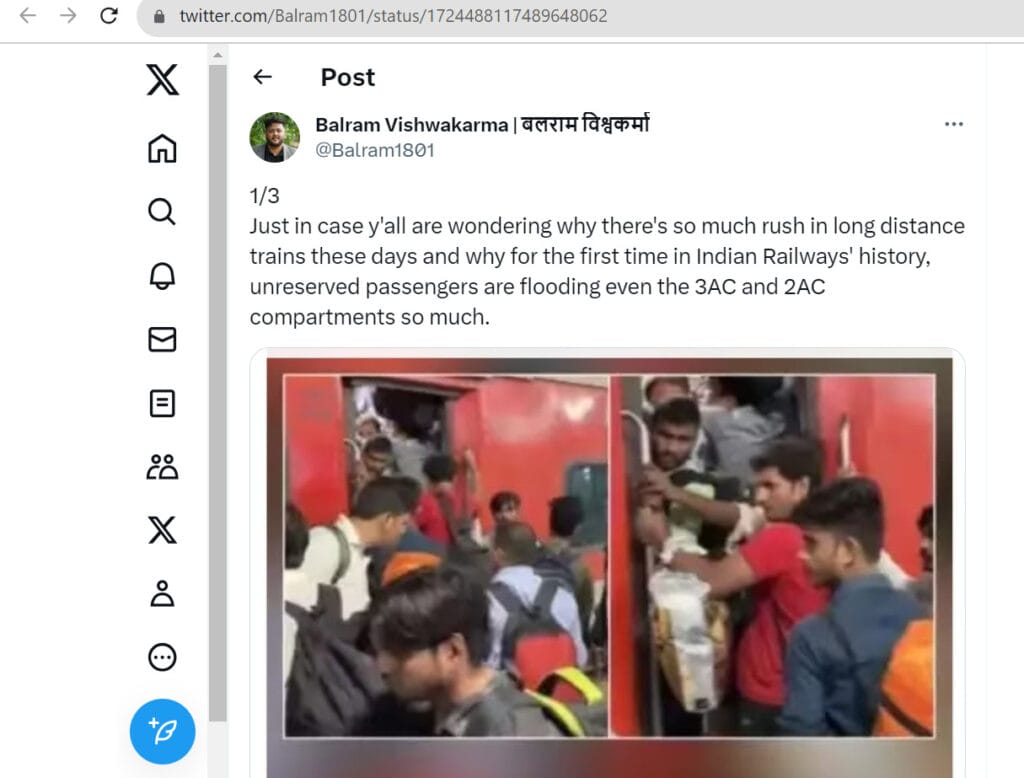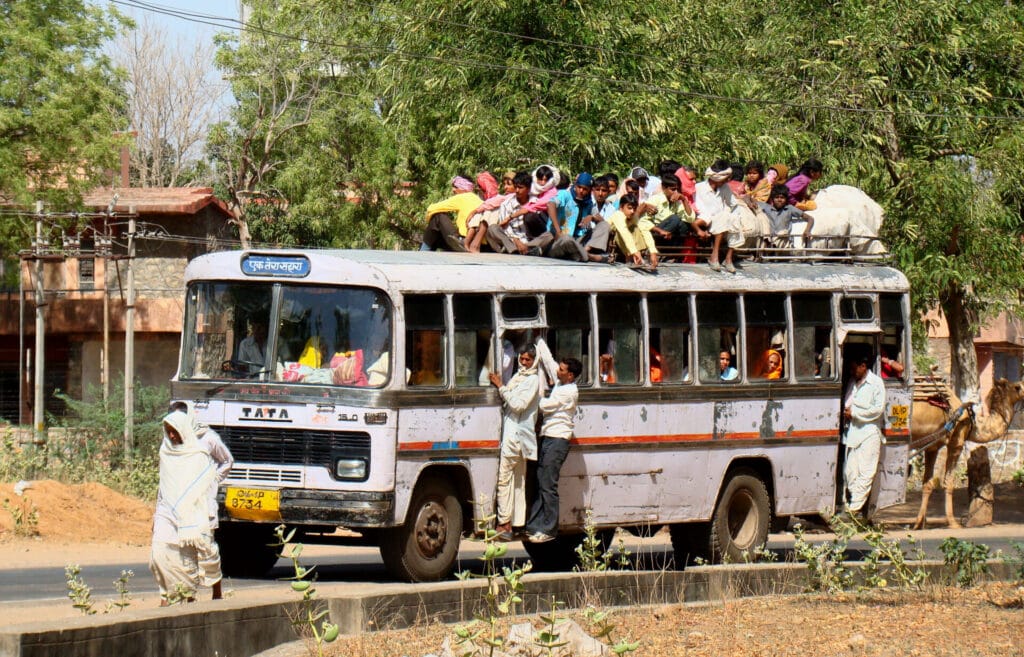At 51 years, N C Bhatra, a migrant labourer in Chennai, finds the 20-hour train journey to his hometown in Puri, Odisha, arduous and costly. So much so that he has limited his trips home to see his wife and two children to just one or two times a year. Bhatra had migrated from Puri to Chennai in 1996. Reserving a ticket in the sleeper coach was much easier then, he says. But over the past five years, he has never been able to book tickets directly as they get sold out much faster.
“To get a ticket nowadays, I have to book it 1-2 months in advance. But this is impossible as the manager does not confirm leaves so early; leaves could also get cancelled later if another worker is unavailable,” he says.
Another migrant from Bihar working in Mumbai, 24-year-old Santosh Kumar also says that sleeper ticket reservation was relatively easier around 2015, when he first came to the city. “At the time, I could get a sleeper ticket two weeks before the travel date, but now this is impossible. I only have the option to travel in general compartments.”
So has the demand for rail travel tickets really shot up? The truth may, at least in part, lie elsewhere.
Like other inter-state migrant labourers, Bhatra and Santosh are reeling under the impact of Indian Railways’ policy of reducing sleeper (SL) coaches over time. For example, the Shalimar-Chennai Coromandel Express (passing via Bhubaneswar) currently has only five sleeper coaches, but reports of the train’s accident in 2009 indicate that it had at least 11 sleeper coaches at the time.
There is other indicative evidence too. A document compiled by citizen activist Balram Vishwakarma indicates the reduction in sleeper coaches in various trains over the years.

Under the circumstances, workers are unable to afford the pricier AC coaches. Besides, long-distance trains covering the interstate migrant corridors are few in number, and they usually have only 2-3 general seating (unreserved) compartments which are chronically crowded. “At my age I can’t travel in the general compartment,” says Bhatra.
Over the past five years, he has been relying entirely on agents to reserve tatkal tickets, which pushes up costs. “The sleeper ticket usually costs Rs 800. But due to the higher price for a tatkal ticket and the agent’s commission, the cost goes up to Rs 1,300-1,350,” he says. “I do feel like going home more often, especially during festivals. But my salary as a machine operator is only around Rs 19,000 per month, and I can’t afford the high ticket prices. On one occasion, I even had to book a tatkal ticket in a 3AC coach as the sleeper ticket was unavailable.”
- Indian Railways’ response to an RTI application showed that, between 2009 and 2022, out of the total reserved seats, the share of sleeper berths dipped by around 23% in the migrant corridor routes of Howrah-Bengaluru, Howrah-Chennai and Howrah-Hyderabad. The share of sleeper berths declined from 73-79% to 51-56% over this period, as the proportion of AC berths increased.
- An analysis in The Hindu showed that, considering only the reserved passenger category between the decade of 2009-10 and 2019-20, the share of passengers carried in AC coaches increased by 9.8%. Whereas the share of passengers carried in sleeper and second-sitting reserved compartments declined by 2.8% and 6.6% respectively.
Common experiences
Younger migrants in cities like Mumbai and Vapi say that sleeper coach tickets would be available only if booked 2-3 months in advance. In addition to the uncertainty about leave sanction etc., these workers in the unorganised sector get their pay settled only a few days before their travel date, making ticket reservations almost impossible.

Ahead of Chhath Puja this November, Santosh had bought a general ticket from Mumbai to Gaya costing around Rs 420, but was unable to board the train due to the crowd. “Since I could not enter the general compartment, I tried entering a sleeper coach. But there, even people with reserved sleeper tickets were standing near the toilet, unable to get to their seats. Many people were standing inside the toilets as well. I felt I might die in the crowd, and decided not to go,” he says. He then had to buy another ticket to travel home two days later.
Only one train goes directly from Mumbai through Gaya daily, with travel time of around 28 hours. Santosh says he usually has to stand throughout the journey. “People are usually sitting on the floor, standing, or even staying put in the toilets.”
For his return trip to Mumbai, he does not board the train from Gaya station just 30 minutes away from his home. Instead, he travels all the way to Koderma Junction station in Jharkhand to increase his chance of getting a seat. “I leave home by 4 pm, travel by bus and local train to reach Koderma station by around 8 pm. Then I sleep in the station overnight, and board the train early in the morning,” he says.
Chandan Kumar, 21, a textile worker in Vapi, Gujarat, recalled the horror of once having to stand 20 hours straight in a train while having fever. “I was going home to Gaya since I was unwell. But the journey worsened my condition and my feet were swollen by the time I reached,” he says. Like Santosh Kumar, he too had not been able to board the train home this Diwali due to crowds.
Chandan Kumar and Raju Vishwakarma, a Mumbai-based worker hailing from Prayagraj, UP, say they were forced to pay fines for boarding sleeper coaches at times, as they had been unable to board the general compartment. While their general ticket costs Rs 300-400, paying fines in the sleeper coach would bring the total to around Rs 1,000.
Salem-based Ganesan, a member of the Tamil Nadu Construction Workers’ Welfare Board, says that overcrowding in these trains could even be leading to deaths. Recently, upon the requests of organisations supporting migrant labourers, Ganesan had traced the bodies of two migrants who had fallen out of a Kerala-bound train in Salem district.
Though the exact cause of death is difficult to ascertain in such cases, Ganesan says, “The general compartments have capacity of only around 100 each, but around 400 people are often cramped into each coach. We couldn’t tell where these two workers were going or who their employer was, so their families could not get any compensation.”
In denial
A senior official at Indian Railways (IR), however, said that the total number of sleeper coaches would not have reduced, as the railways had in fact introduced more trains post-Covid.
“Before Covid, IR was running 10,186 trains across the country, which has now increased to 10,754. Out of this, the mail/express category trains have increased from almost 1,800 to 2,100. Railway ministry also plans to introduce 3,000 more trains in the next five years so as to reduce waiting lists. Hence the total capacity of trains has increased,” he said.
When asked about the declining proportion of sleeper coaches over the years, he said the proportion would have remained the same, but he did not have any data on this.
To a question on ensuring safe travel for migrant workers, the official said that IR does not consider migrants as a separate category, and is not considering providing separate services for them.
Demand for safe travel
After the Coromandel Express train mishap this June that claimed 296 lives, most of whom were migrants, several NGOs wrote to chief ministers of multiple states on facilitating safe travel for workers. Their demands included:
- Identifying migrant hotspots and travel patterns
- Introducing more general compartments in the trains in migrant corridors
- Introducing dedicated weekly trains with general compartments for migrant workers
- Providing booking information in various regional languages to aid migrant workers not proficient in Hindi
- Providing subsidised canteen facilities to avoid hunger during travel
- Capturing the names and mobile numbers of people who buy unreserved train tickets, to serve as a database during emergencies
But one of the petitioners, who did not want to be identified, says they have received no acknowledgement from the states except a formal response from the Kerala CM.
Most migrant workers are recruited in groups by contractors who are supposed to ensure their travel and accommodation. As per Sections 12 to 16 of the Inter-State Migrant Workmen Act, 1979, contractors should get workers registered in the source and destination states, and should themselves be registered.
They should also give workers a ‘displacement allowance’ equal to 50% of their monthly wages at the time of recruitment, and journey allowances that cover the cost of trips to and from home. They should also issue a bookpass to each worker that captures the details of their work and the benefits payable.
But as states lack mechanisms to enforce the law, migrants usually bear travel and accommodation expenses themselves. Besides, contractors are often no more than workers with a few years of experience, and are incapable of solving systemic problems, NGOs say.
Read more: Why government schemes aren’t reaching those who need it the most
Many travel by buses too
Besides the shortfall of train seats, another issue is that many source districts don’t have direct trains connecting them to destination cities. This has led to bus routes evolving along migrant corridors, especially since the 2020 migrant distress, says Benoy Peter, Executive Director at the Centre for Migration and Inclusive Development.
“For example, nearly two lakh out of the six lakh migrant workers in Kochi are from Murshidabad in West Bengal. Since there are no trains connecting Murshidabad to Kochi, private buses now regularly ply in this route. A bus ticket in this route costs Rs 3,000-3,500,” Benoy says.
A report, prepared around 2010 by the NGO Aajeevika Bureau, had found that bus journeys could be perilous too. The report on migrant workers travelling along the relatively short Rajasthan-Gujarat route had found it was common for workers to sit atop the buses due to crowds, which sometimes led to their deaths from falls or electrocution by electric lines. “The situation still remains the same,” says Divya Verma of Aajeevika Bureau.

The need of the hour
NGOs say that, as a start, Indian Railways can easily map the migrant corridors, especially smaller source stations (like Kantabhanji in Odisha) whose ticket sales to cities rocket in certain seasons. Then, it should introduce extra coaches or trains along these routes.
Balram Vishwakarma says that IR should also have a system to inform migrant workers early on, regarding special trains that are introduced around holidays like Diwali. “They can reach out to, say, workers’ unions or migrants’ associations, so that workers can plan and reserve tickets earlier. Currently workers don’t get this information.”
Divya of Aajeevika Bureau says that the provisions under the Inter-State Migrant Workmen Act can be implemented only through a tripartite arrangement between the worker’s principal employer, and his source and destination states. The three parties can coordinate regarding fund and resource allocation for workers, and providing them with facilities. “For example, all urban local bodies have a labour officer attached to them. This person can be the nodal officer for registering migrants and for ensuring they have facilities,” she says.